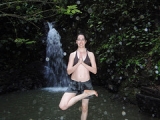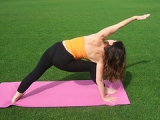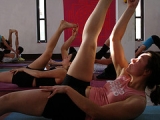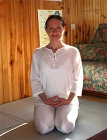Improve Your Posture -Ardha Padmasana
Good Posture Through Yoga:

Ardha Padmasana (Half Lotus Pose):
Stand up straight. Inhale. Bend right leg at the knee. Place the right foot high up on the left thigh. The higher the foot the better indication it is of your flexibility. However, beginners may keep the foot only as high as is comfortable. Now place hands together in namaste gesture at the chest or overhead. Hold for a few seconds, breathing normally. Release and repeat the entire sequence for the other side. Over the next few weeks, increase the time in the pose to 1-2 minutes for each side.
How It Improves Posture: It improves balance which affects posture directly. It trains the cerebellum, the part of the brain involved with balance and posture, back to youthfulness.
Other Benefits: The effect on cerebellum improves mental equipoise. Concentration is improved. Mental ability to solve problems is improved. Boosts confidence and alleviates shyness.
Using Props: Use wall support initially if your balance is not steady. Lean against a wall or table to do the pose.

Utitha Parsvakonasana (Raised Twisted Angle Pose):
Stand up straight. Spread legs a metre apart. Flare out left foot. Bend down left leg at knee. Bend it so that it forms a right angle with the floor. Place right hand palm down on the floor beside the left foot. Now adjust left hand so that it slants in front of you at a neat angle. If done with precision and flexibility, the pose creates a neat, slanting line that starts from your finger tips and ends at the leg extended behind. Throughout the time you execute the pose keep breathing normally. Focus your eyes on the left hand held above. Release. Repeat for the other side.
How It Improves Posture: All the above poses worked on the upper torso and balance but this one involves the lower half of the body, so the entire body is engaged in rectifying your posture. The legs become stronger, more flexible, contributing to a better support for the entire body weight – this is crucial for having an elegant carriage.
Other Benefits: It is therapeutic in upper and middle back problems. It is used to rectify respiratory problems. Tones limbs. Aids weight loss if held for long.
Using Props: This cannot be done with props, but you may adapt the pose to your body by not bending too low but just up to capacity. Slowly, as you gain flexibility and strength, this pose will come naturally to you so you may dip down deeper.

Supta Padangushtasana (Lying Leg Raise Pose):
This is a simple pose but the fact that most people cannot execute it properly is an indication of a bad and unhealthy posture. Lie down on your back. If having lower back pain, bend both legs so that feet are close to hips. Inhale. Exhale, raise up right leg so it is at right angle to the floor. Keep the leg straight. Keep on breathing, extending right arm to clasp the right foot at the big toe. If that is not possible, touch the leg wherever you can – thigh, knee, shin, etc. Release and repeat 3-5 times. Relax and repeat entire sequence for the left leg.
How It Improves Posture: It works out the entire muscle system involved with orchestrating a good posture. The legs become strong, supple and elastic, helping support body weight better. The spine gets a powerful traction, adding to these effects.
Other Benefits: This is an all-around pose that is used as therapy in most ailments. It is the first line of defense in BP and diabetes. Helps heal spinal problems. Used to treat respiratory ailments. It is a cleansing, detoxifying pose.
Using Props: You can use a belt, which is passes around the raised foot. Holding on to it with your hands will help you keep your raised leg straighter.

Vajrasana (Thunderbolt Pose):
Sit on your heels. Rest hips on the heels. Plump persons may spread out knees. Others must try to keep knees together. In this posture, your big toes should touch each other while heels must flare out. This creates a nice hold on which the hips may be placed. Hold the pose for just a few seconds initially. Slowly increase time in pose over the next few weeks so you can hold the pose comfortably for five minutes or more.
How It Improves Posture: This is the only meditative pose in which the spine becomes naturally erect in a relaxed and complete fashion.
Other Benefits: Heals prostate problems in men. Rectifies uro-genital problems in women. Boosts digestion and metabolism. It improves acidity. Rectifies spinal problems. Improves respiration. Controls diabetes and blood pressure.
Using Props: Use a towel. You can either place it between the heels or hips or place it between floor and feet to relieve the pain you are likely to experience initially.

Standing Side Stretch (Ardha Chandrasana):
1. Starting in Mountain pose, take your feet a little further apart and slowly raise your arms above your head as you breathe in. Grasp your right wrist with your left hand as you breathe out.
2. On the next inbreath, lean to the left, facing forwards and bending sideways from the waist. Don’t let your head, arms or torso flop; hold the position strongly and feel strength radiating from your fingers. Return to the centre on an outbreath and repeat on the other side, holding your left wrist.
The Tree (Vrksasana):
Standing straight and looking straight ahead, take a moment to feel balanced and firmly rooted. Bending your right leg, place your foot as close to the top of your inside left thigh as you can comfortably reach, lifting it into position with your right hand if you wish. Stretch your right knee out to the side.
2. To help keep your balance, fix your gaze on something motionless at about eye level. Spread out the toes of your left foot to grip the floor firmly. Breathing in, put your palms together with fingers pointing upwards as if making the Indian greeting Namaste. Try to hold this position for about 5 seconds, breathing naturally.
3. On an inbreath stretch your arms straight above your head and turn your palms inwards. Feel the stretch from your raised hands to your feet, and the energy travelling the length of your body. Aim to hold for upto 20 seconds, breathing naturally. On an outbreath, bring your hands down, first to Namaste level, then down by your sides. Return your right foot to the floor and stand for a moment feeling grounded. Then repeat the exercise on the other side.